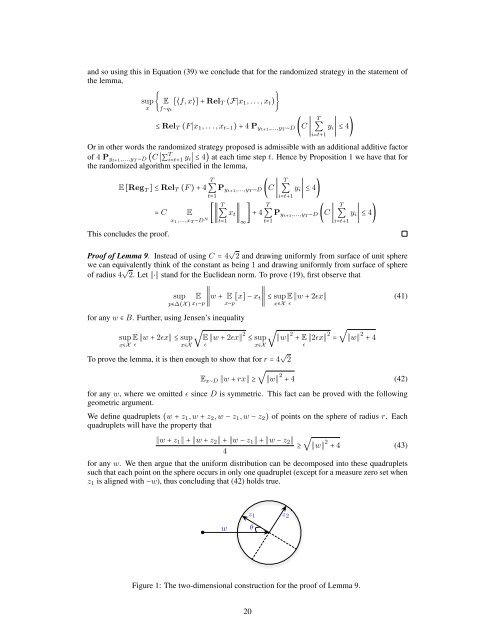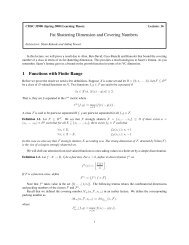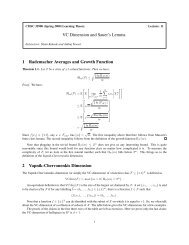Relax and Randomize: From Value to Algorithms
Relax and Randomize: From Value to Algorithms
Relax and Randomize: From Value to Algorithms
You also want an ePaper? Increase the reach of your titles
YUMPU automatically turns print PDFs into web optimized ePapers that Google loves.
<strong>and</strong> so using this in Equation (39) we conclude that for the r<strong>and</strong>omized strategy in the statement of<br />
the lemma,<br />
sup { E [⟨f, x⟩] + Rel T (F∣x 1 , . . . , x t )}<br />
x f∼q t<br />
≤ Rel T (F ∣x 1 , . . . , x t−1 ) + 4 P yt+1,...,y T ∼D (C ∣<br />
T<br />
∑<br />
i=t+1<br />
y i ∣ ≤ 4)<br />
Or in other words the r<strong>and</strong>omized strategy proposed is admissible with an additional additive fac<strong>to</strong>r<br />
of 4 P yt+1,...,y T ∼D (C ∣∑ T i=t+1 y i ∣ ≤ 4) at each time step t. Hence by Proposition 1 we have that for<br />
the r<strong>and</strong>omized algorithm specified in the lemma,<br />
E [Reg T ] ≤ Rel T (F ) + 4 ∑ P yt+1,...,y T ∼D (C ∣<br />
This concludes the proof.<br />
= C E<br />
T<br />
t=1<br />
T<br />
[∥∑<br />
x 1,...,x T ∼D N t=1<br />
x t ∥<br />
∞<br />
T<br />
T<br />
∑<br />
i=t+1<br />
y i ∣ ≤ 4)<br />
] + 4 ∑ P yt+1,...,y T ∼D (C ∣<br />
t=1<br />
T<br />
∑<br />
i=t+1<br />
y i ∣ ≤ 4)<br />
Proof of Lemma 9. Instead of using C = 4 √ 2 <strong>and</strong> drawing uniformly from surface of unit sphere<br />
we can equivalently think of the constant as being 1 <strong>and</strong> drawing uniformly from surface of sphere<br />
of radius 4 √ 2. Let ∥⋅∥ st<strong>and</strong> for the Euclidean norm. To prove (19), first observe that<br />
sup<br />
E<br />
p∈∆(X ) x t∼p<br />
∥w + E<br />
x∼p<br />
[x] − x t ∥ ≤ sup<br />
for any w ∈ B. Further, using Jensen’s inequality<br />
√<br />
sup E ∥w + 2ɛx∥ ≤ sup E ∥w + 2ɛx∥ 2 ≤ sup<br />
x∈X ɛ<br />
x∈X ɛ<br />
x∈X<br />
√<br />
x∈X<br />
E ∥w + 2ɛx∥ (41)<br />
ɛ<br />
∥w∥ 2 + E<br />
ɛ<br />
√<br />
∥2ɛx∥ 2 = ∥w∥ 2 + 4<br />
To prove the lemma, it is then enough <strong>to</strong> show that for r = 4 √ 2<br />
√<br />
E x∼D ∥w + rx∥ ≥ ∥w∥ 2 + 4 (42)<br />
for any w, where we omitted ɛ since D is symmetric. This fact can be proved with the following<br />
geometric argument.<br />
We define quadruplets (w + z 1 , w + z 2 , w − z 1 , w − z 2 ) of points on the sphere of radius r. Each<br />
quadruplets will have the property that<br />
√<br />
∥w + z 1 ∥ + ∥w + z 2 ∥ + ∥w − z 1 ∥ + ∥w − z 2 ∥<br />
≥ ∥w∥ 2 + 4 (43)<br />
4<br />
for any w. We then argue that the uniform distribution can be decomposed in<strong>to</strong> these quadruplets<br />
such that each point on the sphere occurs in only one quadruplet (except for a measure zero set when<br />
z 1 is aligned with −w), thus concluding that (42) holds true.<br />
w<br />
z 1<br />
✓<br />
z 2<br />
Figure 1: The two-dimensional construction for the proof of Lemma 9.<br />
20




